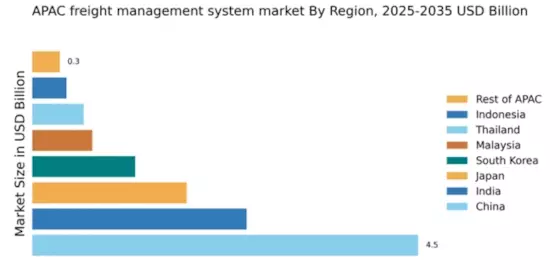Expansion of Trade Agreements
The freight management system market in APAC is significantly influenced by the expansion of trade agreements among countries in the region. These agreements aim to reduce tariffs and facilitate smoother cross-border trade, thereby increasing the volume of goods transported. For instance, the Regional Comprehensive Economic Partnership (RCEP) is expected to enhance trade flows among member countries, potentially boosting logistics activities. As trade volumes rise, the demand for efficient freight management systems escalates, as businesses require robust solutions to handle increased operational complexities. The freight management system market in APAC is likely to benefit from this trend, as companies seek to leverage technology to navigate the intricacies of international logistics.
Growing Focus on Sustainability
Sustainability has emerged as a critical driver for the freight management-system market in APAC. With increasing awareness of environmental issues, companies are actively seeking ways to reduce their carbon footprint. This shift is prompting the adoption of eco-friendly logistics practices, including the use of alternative fuels and optimized routing. According to estimates, logistics operations contribute to around 7% of global greenhouse gas emissions, underscoring the urgency for change. As businesses in APAC prioritize sustainability, the demand for freight management systems that incorporate green logistics solutions is likely to rise. These systems enable organizations to track emissions, optimize transportation routes, and implement sustainable practices, thereby aligning with broader environmental goals.
Technological Integration in Logistics
The freight management system market in APAC is witnessing a transformative phase due to the integration of advanced technologies. Innovations such as artificial intelligence (AI), machine learning, and the Internet of Things (IoT) are reshaping logistics operations. These technologies facilitate real-time data analysis, predictive analytics, and automated decision-making, which enhance overall efficiency. For example, AI-driven algorithms can optimize routing and reduce fuel consumption, leading to cost savings. As businesses increasingly recognize the benefits of technological integration, the freight management-system market in APAC is likely to expand. Companies are investing in systems that leverage these technologies to improve operational performance and customer satisfaction.
Rising Demand for Supply Chain Efficiency
The freight management system market in APAC experiences a notable surge in demand for enhanced supply chain efficiency. Companies are increasingly seeking solutions that streamline operations, reduce costs, and improve delivery times. This trend is driven by the need to remain competitive in a rapidly evolving market. According to recent data, logistics costs in APAC account for approximately 13% of GDP, highlighting the potential for optimization. As businesses strive to minimize these expenses, the adoption of advanced freight management systems becomes essential. These systems facilitate real-time tracking, automated processes, and data analytics, which collectively contribute to improved operational efficiency. Consequently, the freight management-system market in APAC is poised for growth as organizations prioritize supply chain optimization.
Increasing Urbanization and Infrastructure Development
Urbanization in APAC is accelerating, leading to significant implications for the freight management-system market. As populations in urban areas grow, the demand for efficient logistics solutions intensifies. Infrastructure development, including the construction of new roads, ports, and railways, is essential to support this urban growth. According to projections, urban areas in APAC are expected to account for over 50% of the region's population by 2030, necessitating enhanced logistics capabilities. The freight management-system market in APAC is likely to benefit from this trend, as companies seek to adapt to the challenges posed by urbanization. Efficient freight management systems will be crucial in navigating congested urban environments and ensuring timely deliveries.


















Leave a Comment